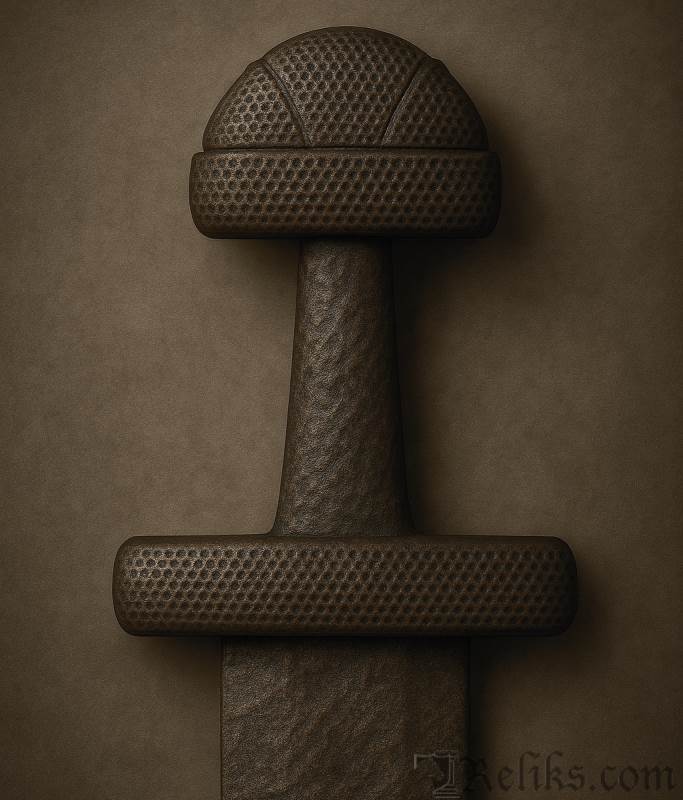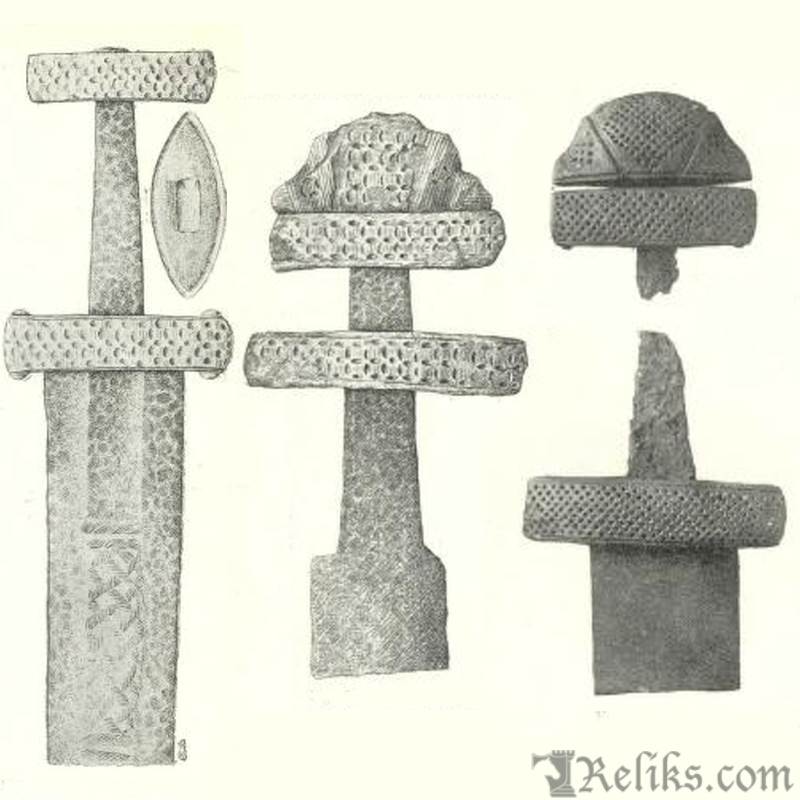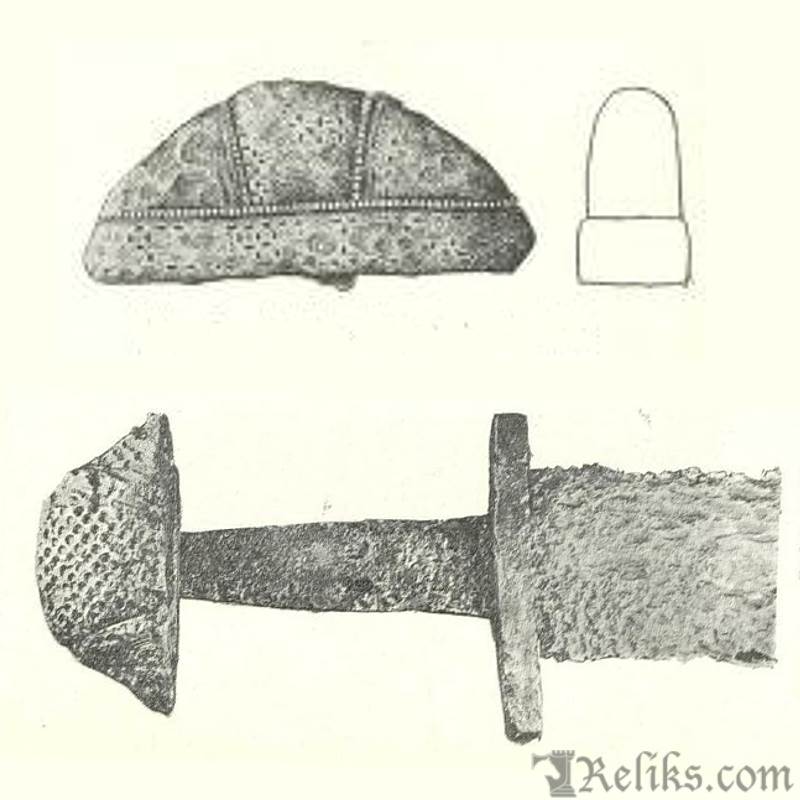Viking Sword Type E – Decorated Swords of Early Viking Expansion
A Homegrown Development from Type D
Type E swords clearly descend from the lavishly ornamented Type D, retaining their heavy guards and three-part pommels but introducing new decorative schemes. While not as monumental as Type D, they carry the same sense of weight and prestige — weapons made to impress both on the battlefield and in the hall.
Archaeological Description

Decorated Swords of Early Viking Expansion
Type E swords are recognizable by their three-part pommel, often flanked by animal-head shaped lobes, and solid, oval-section guards that taper toward the ends. Like Type D, they are richly decorated, though the techniques differ.
The defining feature is the use of round or oval punched depressions in the iron, often arranged in rows or cross-patterns. Sometimes these form squares or crosses, with the pommel’s central panel bearing a distinct square of punched marks. In some examples, twisted bronze or silver wire was laid into grooves dividing the pommel sections. Others display bronze or silver bands set along the guard edges, or entire surfaces plated with hammered sheets of precious metal.
Notably, one specimen from Vågå preserves beaded bronze wire in the pommel grooves, while others show flat bronze or silver strips set along the upper and lower guard edges. A sword from Gloppen even shows bronze sheet hammered into incised grooves, similar to the technique used later on Type H swords.
Though often large and imposing, some Type E swords are more modest, with slimmer guards and smaller pommels, showing variation within the type.
Relationships to Other Types

Petersen Sketches (fig.61,62-65)
Type E is a direct descendant of Type D, sharing the three-part pommel and massive guards, but evolving toward lighter, more standardized forms. Ornamentation shifted from raised inlay panels to punched patterns and wire decoration, suggesting an effort to streamline while still producing impressive weapons.
Several swords blur the line between D and E, such as the Valdres example with panel rows of studs resembling both types. Petersen also noted that Type E sometimes overlaps in time with Type M, with one Opdal sword showing an M-type hilt fitted with an older E-type pommel — evidence that pommels could be reused and treasured even after the blade was replaced.
Historical & Cultural Context
Type E swords belong to the early Viking Age, primarily the first half of the 9th century, though examples continued into the later 9th and possibly the 10th century in Trøndelag.
This was the era of the earliest large-scale Viking expeditions: raids into Ireland, the founding of Norse settlements in the British Isles, and expanding power struggles within Scandinavia. Type E swords, richly ornamented with bronze, silver, and decorative punching, reflect this age of rising prestige and outward expansion.
The use of punched decoration rather than inlaid panels suggests that smiths were adapting older foreign-inspired styles into a more distinctly Scandinavian expression, both simpler to produce and more widely distributed.
Distribution and Finds

Petersen Sketches (fig.64-66)
Petersen recorded 31 examples in Norway, far more common than Type D. They are especially concentrated in Trøndelag and eastern Norway, while curiously absent from Buskerud, Bratsberg, Nedenes, Lister, Mandal, and Stavanger. On the west coast, Voss marks their southernmost extent.
Outside Norway, Type E swords have been found in:
- Sweden (Uppland, Gästrikland, Gotland, Bohuslän).
- Finland (several recorded by Aspelin).
- Denmark (at least one in the Nationalmuseet).
- Ireland (Kilmainham, alongside the famous Type D).
Associated finds include spearheads (Types E and F, occasionally C), axeheads (mostly B–D, with some A and E), and shield bosses (R 564, occasionally lower R 562–63). In two cases, older rattle amulets accompanied the swords.
Several swords also show pattern-welded blades — eight examples with flame-like patterns or plaited band motifs — and at least one possible inscription, though some “inscriptions” turned out to be decorative patterns rather than true lettering.
For Collectors and Enthusiasts
Type E is especially exciting for enthusiasts because of its variety and decoration. With bronze wire, silver bands, punched crosses, and even rune-marked examples, no two swords look quite alike. Their wider distribution also makes them easier to trace in museum collections across Scandinavia and even Ireland.
For collectors and reenactors, Type E shows how Viking smiths balanced weight, power, and visual prestige. They are less extreme than Type D but still striking, representing a more distinctly Scandinavian style.
Closing Reflection
Type E swords capture a moment of transition: still rooted in the ornate, heavy prestige weapons of the early 9th century, but moving toward more accessible, widespread Viking forms. Their decorated guards and punched motifs reflect a uniquely Norse approach to sword-making — a blend of inherited grandeur and practical adaptation.
Core classification based on Jan Petersen, De Norske Vikingesverd (1919). Additional commentary by Reliks.com.